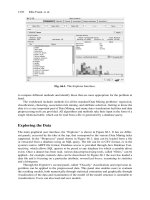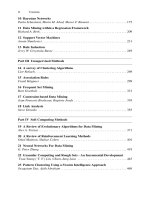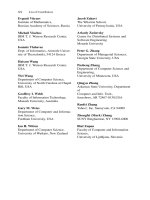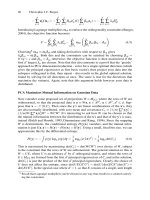Data Mining and Knowledge Discovery Handbook, 2 Edition part 48 potx
Bạn đang xem bản rút gọn của tài liệu. Xem và tải ngay bản đầy đủ của tài liệu tại đây (101.78 KB, 10 trang )
450 Tsau Young (’T. Y.’) Lin and Churn-Jung Liau
Proposition 2 An equivalence relation on U ⇔ a partition on U
In RST, the pair (U,A) is called an approximation space and its topological properties
are studied.
22.4.2 Binary Relation (Granulation) - Topological Partitions
In (Lin, 1998b), we observe that there is a derived partition for each BNS, that is, the
map B : V → 2
U
; p → B(p) induces a partition on V; the equivalence class C(p)=
B
−1
(B(p)) is the center of B(p). In the case V = U, the B(p) is the neighborhood of
C(p), and C(p) consists of all the points that have the same neighborhood. So B(p)=
B((C(p)). We observe that {C(p)} is a partition. Since each B(p) is a neighborhood
of the set C(p). The quotient set is a BNS (Lin, 1989a). We will call the collection of
C(p) topological partition with the understanding that there is a neighborhood B(p)
for each equivalence class C(p). The neighborhoods capture the interaction among
equivalence classes (Lin, 2000).
22.4.3 Fuzzy Binary Granulations (Fuzzy Binary Relations)
In (Lin, 1996), we have discussed various fuzzy sets. In this chapter, a fuzzy set is
uniquely defined by its membership function. So a fuzzy set is a w-sofset, if we use
the language of the cited paper.
A fuzzy binary relation is a fuzzification of a binary relation. Let I be the unit
interval [0, 1]. Let FBR be a fuzzy binary relation, that is, there is a membership
function: FBR : V ×U → I : (p,u) → r. For each p ∈V, there is a fuzzy set whose
membership function FM
p
: U →I is defined by FM
p
(u)=FBR(p,u), we call FM
p
a fuzzy binary neighborhood/set.
Again, we can view the idea geometrically. We assume a fuzzy binary neigh-
borhood system (FBNS) is imposed for V on U. For each object p ∈ V , we as-
sociate a fuzzy subset, denoted by FB(p) ⊆ U. In other words, we have a map
FB : V → FZ(U) : p → FB(p), where FZ(U ) means all fuzzy subsets on U. FB(p)
is called a fuzzy binary neighborhood and FB a fuzzy binary granulation (FBG) and
the collection {FB(p)|p ∈V} a fuzzy binary neighborhood system (FBNS).
It is clear that given a map FB, there is a binary relation FBR such that FM
p
=
FB(p). So as in crisp cases, from now on we will use algebraic and geometric terms
interchangeably. FB, FBNS, FBG, and FBR are synonyms.
22.5 Non-partition Application - Chinese Wall Security Policy
Model
In 1989 IEEE Symposium on Security and Privacy, Brewer and Nash (BN) pro-
posed a very intriguing security model, called Chinese Wall Security Policy (CWSP)
model. Intuitively BN’s idea was to build a family of impenetrable walls, called Chi-
nese Walls, among the datasets of competing companies so that no datasets that are
22 Granular Computing and Rough Sets - An Incremental Development 451
in conflict can be stored in the same side of Chinese Walls; this is BN’s requirements
and will be called Aggressive (Strong) Chinese Wall Security Policy (ACWSP) Model.
The methods are based on the formal analysis of the binary relations (CIR) of
conflict of interests. Roughly, BN granulated the data sets by CIR and assumed the
granulation was a partition. CIR is rarely an equivalence relation, for example, a com-
pany cannot be self conflicting; so reflexivity can never met by CIR. So a modified
model, called an aggressive Chinese Wall Security Policy model (ACWSP) is pro-
posed (Lin, 1989b). However, in that paper, the essential strength of ACWSP model
had not brought out. With recent development in GrC, ACWSP model was refined
(Lin, 2003a), and successfully captured the intuitive intention of BN ”theory.”
CWSP Model is essentially a Discretionary Access Control Model (DAC). The
central notion of DAC is that owner of an object has discretionary authority on the
access rights of that objects. The owner X of the dataset x may grant the read access
of x to a user Y who owns a dataset y. The use Y may make a copy, Copy-of-x, in
y. Even in the strict DAC model, this is permissible (Osbornet al., 2000)). We have
summarized the above grant access procedure, including making a copy, as a direct
information flow (DIF) from X or x to Y or y respectively.
Let O be the set of all objects (corporate data),X and Y are typical objects in O.
CIR ⊆ O ×O represents the binary relation of conflict of interests. We will consider
the following properties:
• CIR-1: CIR is symmetric.
• CIR-2: CIR is anti-reflexive.
• CIR-3: CIR is anti-transitive.
22.5.1 Simple Chinese Wall Security Policy
In (Brewer and Nash, 1988), Section ”Simple Security”, p. 207, BN asserted that
”people are only allowed access to information which is not held to conflict with any
other information that they already possess.” So if (X,Y ) ∈ CIR, then X and Y could
be assigned to one single agent. So we assume that information in X and Y have been
disclosed to each other (since one agent knows both). So outside of CIR-class, there
are direct information flows between any two objects.
Definition 3 Simple CWSP : Direct Information Flow (DIF) may flow between X
and Y if and only if (X,Y ) ∈ CIR,
Simple CWSP is a requirement on DIF, it does not prevent information flow
between X and Y indirectly. So we need composite information flow (CIF). By a CIF,
we mean information flow between X and Y via a sequence of DIF’s. An information
flow from X to Y is called a malicious Trojan horse, if Simple CWSP is imposed on
X and Y
.
452 Tsau Young (’T. Y.’) Lin and Churn-Jung Liau
Definition 4 (Strong) ACWSP: CIF may flow between X and Y if and only if
(X,Y) ∈ CIR,
Next, let us quote a theorem from (Lin, 2003a).
Theorem 1 Chinese Wall Security Theorem, If CIR is symmetric, anti-reflexive and
anti-transitive, then Simple CWSP implies (Strong) ACSWP.
22.6 Knowledge Representations
At the current states, knowledge representations are mainly in table or tree formats.
So the knowledge level processing is basically table processing. The main works, we
will present here is the extension of the representation theory of equivalence relations
to binary relations.
22.6.1 Relational Tables and Partitions
(Pawlak, 1982) and (Lee, 1983) observed that: A relational table is a knowledge rep-
resentation of a universe of entities. Each column induces a partition on the universe;
n columns induce n partitions. Here, we will explore the converse. How could we
represent a finite set of partitions? The central idea is to assign meaningful name ( a
summary ) to each equivalence class (Lin, 1998a, Lin, 1998b, Lin, 1999b).
We will illustrate the idea by example: Let U = {id
1
,id
2
, ,id
9
} be a set of 9
balls with two partitions:
(1) {{id
1
,id
2
,id
3
},{id
4
,id
5
},{id
6
,id
7
,id
8
,id
9
}}
(2) {{id
1
,id
2
},{id
3
},{id
4
,id
5
},{id
6
,id
7
,id
8
,id
9
}}
We name the first partition COLOR, (because it is the best summarization of the
given partition from physical inspection).
COLOR = Name({{id
1
,id
2
,id
3
},{id
4
,id
5
},{id
6
,id
7
,id
8
,id
9
}})
Next, we will name each equivalence class to reflect its characteristic. We name the
first equivalence class
Red = Name({id
1
,id
2
,id
3
}),
because each ball of this group has red color (appears to human). Note that this name
reflects human’s observation and meaningful to human only; its meaning (such as
light spectrum) is not implemented or stored in the system. In AI, the term COLOR
or Red are called semantic primitive (Barr and Feigenbaum, 1981). The same intent
leads to the following names
Orange = Name({id
4
,id
5
})
Yellow = Name({id
6
,id
7
,id
8
,id
9
})
22 Granular Computing and Rough Sets - An Incremental Development 453
Next, we give names to the second partition, again by its characteristics (appear
to human):
WEIGHT = Name({{id
1
,id
2
},{id
3
},{id
4
,id
5
},{id
6
,id
7
,id
8
,id
9
}})
W1 = Name({id
1
,id
2
})
W2 = Name({id
3
})
W3 = Name({id
4
,id
5
})
W4 = Name({id
6
,id
7
,id
8
,id
9
})
Base on these names, we have Table 22.1:
Table 22.1. Constructing an Information table by naming each partition and equivalence class
U COLOR WEIGHT
id
1
Red W1
id
2
Red W1
id
3
Red W2
id
4
Orange W3
id
5
Orange W3
id
6
Yellow W4
id
7
Yellow W4
id
8
Yellow W4
id
9
Yellow W4
The first tuple can be interpreted as follows: the first ball belongs to the group
that is labeled Red, and another group whose weight is labeled W1. We can do the
same for rest of the tuples. This table is a classical bag relation.
The goal of this chapter is to generalize this naming methodology to general
granulations. The word-representation of partitions is a very clean representation;
each name (word) represents an equivalence class uniquely and independently. In
next section, we will investigate the representations of binary relations, in which
names have overlapping semantics.
22.6.2 Table Representations of Binary Relations
Real world granulation often cannot be expressed by equivalence relations. For ex-
ample, the notions of “near”,“similar”, and “conflict” are not equivalence relations.
So there are intrinsic needs to generalize the theory of partition (RST) to the theory of
more general granulation (granular computing). In this section, we will explain how
to represent a finite set of binary granulations (binary relations) into a table format.
So we can extend the relational theory from partitions to binary granulations. Most
of the results are recall and refinements of the results observed in (Lin, 1998a, Lin,
1998b, Lin, 1999b,Lin, 2000).
The representation of a partition is rested on two properties:
454 Tsau Young (’T. Y.’) Lin and Churn-Jung Liau
(a) Each object p belongs to an equivalence class (the union of equivalence class
covers the whole universe)
(b) No object belongs to two equivalence classes (equivalence class are pairwise
disjoint)
The important question is: Does the family of binary granules have the same
properties as equivalence classes? Obviously, a granulation does satisfy (a), but not
(b), because granules may overlap each other. We need a different way to look at the
problem: we restate the two properties into the following form:
• Each object belongs to one and only one equivalence class
If we assign each equivalence class a meaningful name, then each object is as-
sociated with a unique name (attribute value). Such an assignment construct one
column of the table representation. Each equivalence relation get a column. So n
equivalence relations construct a table of n columns.
With these observations, we can state a similar property for the binary granula-
tion. Let B be a binary granulation
• Each object, p ∈V, is assigned to one and only one B-granule B
p
∈ 2
U
; B : p →
B
p
.
If we assign each B-granule a meaningful name, then each object is associated
with a unique name (attribute value).
p(∈V)
B
→ B
p
(∈ 2
U
)
Name
→ Name(B
p
)(∈ Dom(B)) (22.3)
p → Name(B
p
)(∈ Dom(B)) (22.4)
Such an association allows us to represent
• a finite set of binary granulations by a “relational table”, called granular table.
Note that we did not use the relationships “∈”. Instead, we use the assignment of
neighborhoods (binary granules).
We will illustrate the idea by modifying the last example. In binary granulation
each p is associated with a unique binary neighborhood B
p
. The following neighbor-
hoods are given.
B
id
1
= B
id
2
= B
id
3
= {id
1
,id
2
,id
3
,id
4
,id
5
}
B
id
4
= B
id
5
= {id
1
,id
2
,id
3
,id
4
,id
5
,id
6
,id
7
,id
8
,id
9
}
B
id
6
= B
id
7
= B
id
8
= B
id
9
= {id
4
,id
5
,id
6
,id
7
,id
8
,id
9
}.
By examining the characteristic of each binary neighborhood, we assign their
names as follows:
Having-RED =Name(B
id
1
)=Name(B
id
2
)=Name(B
id
3
)
Having-RED+YELLOW =Name(B
id
4
)= Name(B
id
5
)
Having-YELLOW =Name(B
id
6
)=Name(B
id
7
)=Name(B
id
8
)= Name(B
id
9
)
22 Granular Computing and Rough Sets - An Incremental Development 455
For illustration, let us trace the journey of id
1
: It is an object of V , and is moved
to a subset, B
id
1
, then stop at the name, Having-RED, in notation,
id
1
B
→ B
id
1
Name
→ Having-RED.
By tracing every object of V , we get the second column of Table 22.2. For the
third column, we use the same partition and naming scheme as in the previous sec-
tion; so the third column is exactly the same as that in Table 22.1. The results are
shown in Table 22.2.
Table 22.2. Granular table: Construct granular table by naming each binary granulations and
binary granules
BALLs Granulation 1 Granulation 2
id
1
Having-RED W1
id
2
Having-RED W1
id
3
Having-RED W2
id
4
Having-RED+YELLOW W3
id
5
Having-RED+YELLOW W3
id
6
Having-YELLOW W4
id
7
Having-YELLOW W4
id
8
Having-YELLOW W4
id
9
Having-YELLOW W4
Perhaps, we should stress again that attribute values have overlapping semantics.
The constraints among these words have to be properly handled. So, let us examine
the “interactions” among attribute values of COLOR. Two attribute values, Having-
RED and Having-RED+YELLOW, obviously have overlapping semantics. We need
some preparations. We need one more concept, namely, the center
C
w
= B
−1
(B
p
), (22.5)
where w=Name(B
p
). Verbally, C
w
consists of all objects that have the same B-granule
B
p
. We use the granule’s names to index the centers:
C
Having-RED
≡ Center of B
id
1
= Center of B
id
2
= Center of B
id
3
= {id
1
,id
2
,id
3
}
C
Having-RED+YELLOW
≡ Center of B
id
4
= Center of B
id
5
= {id
4
,id
5
}
C
Having-YELLOW
≡ Center of B
id
6
= Center of B
id
7
= Center of B
id
8
= Center of B
id
9
= {id
6
,id
7
,id
8
,id
9
}
456 Tsau Young (’T. Y.’) Lin and Churn-Jung Liau
Now, we will define the binary relation B
COLOR
in terms of BNS. First we ob-
serve that B
COLOR
is reflexive, so we define the “other” points only. With a slight
abuse of notation, we also denote B
COLOR
by B. Let w,u ∈{Having-RED, Having-
RED+YELLOW, Having-YELLOW}, then:
w ∈ B
u
⇔∀p ∈C
u
,B
p
∩C
w
= /0 ⇔∃p ∈C
u
,B
p
∩C
w
= /0.
Thus, for example, we have: Having-RED+YELLOW ∈ B
Having-RED
since:
B
id
1
∩C
Having-RED+YELLOW
= /0 and: id
i
∈ C
Having-RED
. Analogously, we
have: Having-RED ∈B
Having-RED+YELLOW
etc.
Thus we have defined all B-granules. These B-granules defines a binary relation
on the COLOR column, which is displayed in Table 22.3
Table 22.3. A Binary Relation on COLOR
Having-RED Having-RED
Having-RED Having-RED+YELLOW
Having-RED+YELLOW Having-RED
Having-RED+YELLOW Having-RED+YELLOW
Having-RED+YELLOW Having-YELLOW
Having-YELLOW Having-RED+YELLOW
Having-YELLOW Having-YELLOW
Note that such a binary structure cannot be deduced from the table structure. We
are ready to introduce the notion of semantic property.
Definition 5 A property is said to be semantics if and only if it is not implied by the
table structure. A property is said to be syntactic if and only if it is implied by the
table structure.
The binary relation (Table 22.3) is not derived from the table structure (of Ta-
ble 22.2) so it is a semantic property. This type of tables has been studied in (Lin,
1988, Lin, 1989a) for approximate retrievals; and is called topological relations or
tables. Formally,
Definition 6 A table (e.g. Table 22.2) whose attributes are equipped with binary
relations (e.g. Table 22.3 for COLOR attribute) is called a topological relation.
22.6.3 New representations of topological relations
In (Lin, 2000), the granular table is transformed into topological information table.
Here we will give a hew view and a refinement. By replacing the name of binary
granule with centers in Table 22.2 and 22.3, we have Table 22.4 and Table 22.5; they
are isomorphic. Table 22.5 provides the topology of Table 22.4. Table 22.4 and 22.5
provide a better interpretation than that of Table 22.2 and 22.3.
22 Granular Computing and Rough Sets - An Incremental Development 457
Table 22.4. Topological Table
BALLs Granulation 1 Granulation 2
id
1
C
Having-RED
W1
id
2
C
Having-RED
W1
id
3
C
Having-RED
W2
id
4
C
Having-RED+YELLOW
W3
id
5
C
Having-RED+YELLOW
W3
id
6
C
Having-YELLOW
W4
id
7
C
Having-YELLOW
W4
id
8
C
Having-YELLOW
W4
id
9
C
Having-YELLOW
W4
Table 22.5. A Binary Relation on the Centers of COLOR
C
Having-RED
C
Having-RED
C
Having-RED
C
Having-RED+YELLOW
C
Having-RED+YELLOW
C
Having-RED
C
Having-RED+YELLOW
C
Having-RED+YELLOW
C
Having-RED+YELLOW
C
Having-YELLOW
C
Having-YELLOW
C
Having-RED+YELLOW
C
Having-YELLOW
C
Having-YELLOW
Theorem 2 Given a finite binary relation B, a finite equivalence relation A can be
induced. The knowledge representation of B is a topological representation of A.
22.7 Topological Concept Hierarchy Lattices/Trees
We will examine a nested sequence of binary granulations; the essential ideas is
in (Lin, 1998b,Lin, 2000). Each inner layer is strongly dependent on the immediate
next outer layer (Section 22.8.2).
22.7.1 Granular Lattice
Let us continue on the same example: Each ball in U has a B-granule. Balls 1, 2, 3
have the same B-granule; it is labeled H-Red (abbreviation of Having-Red). Simi-
larly, Balls 4, 5 have H-Red+Yellow, and Balls 6, 7 have H-Yellow.
The nested sequence (length) is display in Figure 22.1 as a tree:
The first generation children:
458 Tsau Young (’T. Y.’) Lin and Churn-Jung Liau
U
H_RED H_Red+Yellow H_Yellow
1, 2, 3, 4, 5 1, 2, 3, 4, 5, 6, 7, 8, 9 4, 5, 6, 7, 8, 9
W1 W2 W3 W3 W4
1, 2 3 4, 5 4, 5 6, 7, 8, 9
ID-1 ID-2 ID-3 ID-4 ID-5 ID-6 ID-7 ID-8 ID-9
W1 W2 W3 W4 ID-4 ID-5
1, 2 3 4, 5 6, 7, 8, 9
ID-1 ID-2 ID-3 ID-4 ID-5 ID-6 ID-7 ID-8 ID-9
Fig. 22.1. In 2nd layer the bold print letters are in the centers.
1. U is granulated into three distinct children; they are named Having-Red Having-
Red+Yellow, Having-Yellow; they are abbreviated to H-Red, H-Red+Yellow,
and H-Yellow.
2. The three children are distinct, but not independent; their meanings have
overlapping. Namely (1) there are interaction between H-Red+Yellow and H-
Red+Yellow; (2) between H-Red+Yellow and H-Yellow; (3) there are NO in-
teractions between H-Red and H-Yellow; The interactions are recorded in Ta-
ble 22.3. This explains how the first level children are produced.
3. Every child has a center: the centers are C
H-RED
(abbreviation of
C
Having-RED
), C
H-RED+Yellow
, C
H-Yellow
. Centers are pairwise disjoint;
they forms a partition.
The second generation children: Since COLOR-granulation strongly depends on
WEIGHT-granulation, each COLOR-granule is a union of WEIGHT-granules. Thus
one can regard that these WEIGHT-granules forms a granulation of this COLOR
granule, so
1. H-Red (a COLOR-granule) is granulated into WEIGHT-granules, W1, W2, W3.
Note that within each COLOR-granule the WEIGHT-granules are disjoint, so
”granulated” is ”partitioned.”
2. H-Red+Yellow is granulated into W1, W2, W3, W4,
3. H-Yellow is granulated into W3, W4. This explains how the second level chil-
dren are produced. We need information about the centers.
4. Since WEIGHT-granulation is a partition, the center is the same as granule.
22 Granular Computing and Rough Sets - An Incremental Development 459
Some Lattice Paths
1. U → H-Red →W1 → id
1
2. U → H-Red →W1 → id
2
3. U → H-Red →W2 → id
3
4. U → H-Red+YELLOW → W 1 → id
1
. This path has the same beginning and
ending with Item 1; but the two paths are distinct.
5. U → H-Red+YELLOW →W 1 → id
2
;compare with Item 2.
6. U → H-Red+YELLOW →W 2 → id
3
; compare with Item 3.
7. U → H-Red+YELLOW →W 3 → id
4
8. etc
22.7.2 Granulated/Quotient Sets
1. The children consists of three (overlapping) subsets, H-Red, H-Red+Yellow, H-
Yellow. This collection is more than a classical set; there are interactions among
them; It forms a BNS-space; see Table 22.3.
2. The grand children:
a) Children of the first child {W 1,W 2,W 3} forms a classical set.
b) Children of the second child {W 1,W 2,W 3,W 4} forms a classical set.
c) Children of the third child: {W 3,W 4} forms a classical set.
3. Three distinct classical sets do have non-empty intersections.
Note that since WEIGHT-granulation is a partition, so the grand children un-
der each individual child are disjoint. However, the grand children do overlap. The
quotient set (of quotient set)
{H-Red, H-Red+Yellow, H-Yellow}
= {{W1,W2,W3},{W2,W3, W4},{W3,W4}}
= {{{id
1
,id
2
},{id
3
},{id
4
,id
5
}},{{id
3
},{id
4
,id
5
},
{id
6
,id
7
,id
8
,id
9
}},{{id
4
,id
5
},{id
6
,id
7
,id
8
,id
9
}}}
22.7.3 Tree of centers
In a granular lattice, children of every generation may overlap. Could we improve
the situation? In deed, if we consider the centers only, then lattice becomes a tree
(Figure 22.1a; observe the bold prints nodes).
1. The children consists of three (non-overlapping) subsets:
a) C
H−Red
= {id
1
,id
2
,id
3
},
b) C
H−Red+Yellow
= {id
4
,id
5
},
c) C
H−Yellow
= {id
6
,id
7
,id
8
.id
9
}.
They froms a classical set.
2. The grand children:
a) Children of the first child: W 1 = {id
1
id
2
}, W 2 = {id
3
}.









